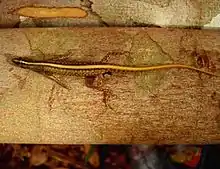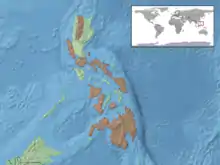| Lipinia pulchella | |
|---|---|
 | |
| Scientific classification | |
| Domain: | Eukaryota |
| Kingdom: | Animalia |
| Phylum: | Chordata |
| Class: | Reptilia |
| Order: | Squamata |
| Family: | Scincidae |
| Genus: | Lipinia |
| Species: | L. pulchella |
| Binomial name | |
| Lipinia pulchella Gray, 1845 | |
| Subspecies | |
|
Three, see text. | |
 | |
| Synonyms[2][3] | |
| |
Lipinia pulchella, known commonly as the yellow-striped slender tree skink or beautiful lipinia, is a species of skink, a lizard in the family Scincidae. The species is endemic to the Philippines.
Subspecies
Three subspecies are recognized as being valid, including the nominotypical subspecies.[3]
- Lipinia pulchella levitoni (W. Brown & Alcala, 1963)
- Lipinia pulchella pulchella Gray, 1845
- Lipinia pulchella taylori (W. Brown & Alcala, 1956)
Nota bene: A trinomial authority in parentheses indicates that the subspecies was originally described in a genus other than Lipinia.
Etymology
The specific name, levitoni, is in honor of American herpetologist Alan Edward Leviton (born 1930).[4]
The specific name, taylori, is in honor of American herpetologist Edward Harrison Taylor (1889–1978).[5]
Habitat
L. pulchella is found at elevations of 250–1,100 m (820–3,610 ft) above sea level throughout the whole country of the Philippines, though its three subspecies occupy smaller geographical regions, which do not necessarily overlap. The skink is found on trunks of trees in the dipterocarp or submontane tropical moist forests.[1]
Reproduction
References
- 1 2 Brown R (2009). "Lipinia pulchella ". The IUCN Red List of Threatened Species 2009. doi:10.2305/IUCN.UK.2009-2.RLTS.T169869A6684371.en
- ↑ Taylor EH (1922). The Lizards of the Philippine Islands. Manila: Government of the Philippine Islands, Department of Agriculture and Natural Resources, Bureau of Science. Publication No. 17. 269 pp. + Plates 1-22. (Leiolopisma pulchellum, pp. 212-214 + Plate 15, figures 5, 5a, 5b).
- 1 2 3 Species Lipinia pulchella at The Reptile Database . www.reptile-database.org.
- ↑ Beolens, Bo; Watkins, Michael; Grayson, Michael (2011). The Eponym Dictionary of Reptiles. Baltimore: Johns Hopkins University Press. xiii + 296 pp. ISBN 978-1-4214-0135-5. (Lipinia pulchella levitoni, p. 157;
- ↑ Brown WC, Alcala AC (1956).
Further reading
- Boulenger GA (1887). Catalogue of the Lizards in the British Museum (Natural History). Second Edition. Volume III. ... Scincidæ ... London: Trustees of the British Museum (Natural History). (Taylor and Francis, printers). xii + 575 pp. + Plates I-XL. (Lygosoma pulchellum, pp. 254-255 + Plate XVII, figures 1, 1a, 1b).
- Brown WC, Alcala AC (1956). "A review of the Philippine lizards of the genus Lygosoma (Leiolopisma) ". Occasional Papers, Natural History Museum, Stanford University (3): 1–10. (Lygosoma pulchellum taylori, new subspecies, p. 8).
- Brown WC, Alcala AC (1963). "Additions to the leiolopismid lizards known from the Philippines, with descriptions of a new species and subspecies". Proceedings of the Biological Society of Washington 76: 69–79. (Lygosoma pulchellum levitoni, new subspecies, pp. 78–79).
- Gray JE (1845). Catalogue of the Specimens of Lizards in the Collection of the British Museum. London: Trustees of the British Museum. (Edward Newman, printer). xxviii + 289 pp. (Lipinia pulchella, new species, p. 84).
